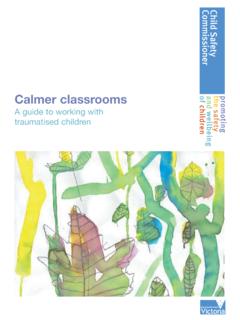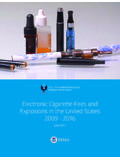Transcription of 584 Calmer Classrooms - earlytraumagrief.anu.edu.au
1 Calmer Classrooms A guide to working with traumatised children Acknowledgements This resource was commissioned by the Child Safety Commissioner. It was written by Laurel Downey, Manager, Practice Development and Training, Take Two, Berry Street Victoria. Laurel would like to acknowledge her Take Two colleagues, Annette Jackson and Lisa McClung for their contribution to her work. The development of the resource was managed by Maree Tehan, Office of the Child Safety Commissioner. Many people contributed to the resource by providing suggestions and feedback. They include teachers from State and Catholic primary and secondary schools, staff from the Department of Education, the Office for Children, Department of Human Services, and community service organisations. Published by the Child Safety Commissioner, Melbourne, Victoria, Australia June 2007.
2 Copyright State of Victoria, Child Safety Commissioner, 2007. This publication is copyright. It may be reproduced in whole or in part for study or training purposes, subject to the inclusion of an acknowledgement of the source and no commercial usage or sale. Also available at or phone the Office of the Child Safety Commissioner on 03 8601 5884. Printed by Penfold Buscombe. Edited by Margaret Jacobs Author Laurel Downey, Manager, Practice Development and Training, Take Two, Berry Street Victoria. Take Two is a statewide developmental mental health service providing a therapeutic response to infants, children and young people who are clients of Child Protection. Take Two provides a service to over 550 traumatised children every year, who are referred by Child Protection workers. Front cover illustration by Daniel, Year 1/2. Foreword This booklet assists kindergarten, primary and secondary teachers, and other school personnel in understanding and working with children and young people whose lives have been affected by trauma.
3 The majority of such children will have come from backgrounds of abuse and neglect, although some of them will have suffered as refugees, or experienced war or dislocation overseas. An even smaller number will have experienced illness, painful medical interventions or one-off traumas such as disasters or accidents. Calmer Classrooms particularly addresses the needs of children who have been traumatised by abuse and neglect. These children may be involved in the child protection and family support systems. Some may not be able to remain in the care of their families and are living in foster care or other forms of state care. I urge teachers and all those involved in children's education to take some time to consider the detail of this publication. Abuse and neglect can have a severe, long lasting impact on children's overall development, which often has the effect of reducing their capacity to concentrate and to learn.
4 By understanding and building relationships with traumatised children, teachers can make an enormous contribution to their lives. Children who develop an attachment to their school and a love of learning will have greater resilience in the face of adversity than those who do not. Throughout this booklet, infants, children and young people will be referred to as children' in keeping with my strong view that, up until the age of 18, all young people are in need of nurturing and loving care. Bernie Geary OAM. Child Safety Commissioner Understanding the experience of the abused and neglected child assists us to develop compassion, patience and empathy. It is a key intervention in itself. Recovery from trauma will occur best in the context of healing relationships. Contents Foreword .. i Introduction: The role of teacher, school and support systems.
5 Iv Section One: Experiencing abuse and neglect often leads to trauma and disturbed attachment .. 1. Attachment and early security: building resilience .. 2. Attachment, trauma and the impact on development .. 3. Section Two: The impact of abuse and neglect on learning .. 9. Case studies .. 10. Impacts on academic performance and social functioning .. 11. Academic performance .. 12. Social functioning .. 13. Affect dysregulation: seen as hyperarousal or dissociation .. 15. Shame: can increase affect dysregulation .. 15. Section Three: Calmer Classrooms relationship-based practices .. 17. Creating connection and defusing conflict .. 18. Planning for challenging incidents .. 22. Teaching Indigenous children .. 25. Self-care for teachers .. 26. Participating in systems: the care team approach .. 27. Conclusion .. 28. A snapshot .. 29.
6 Appendix A: Child Protection and out-of-home care .. 31. Appendix B: Partnering Agreement .. 33. Useful resources .. 34. Glossary .. 35. References .. 36. Introduction The role of teacher, school and support systems Both research and wisdom show us that regardless of the adversity they face, if a child can develop and maintain a positive attachment to school, and gain an enthusiasm for learning, they will do so much better in their lives. The role of teachers in the lives of traumatised children cannot be underestimated. This booklet encourages teachers and other school personnel to forge those attachments through two key mechanisms: understanding traumatised children and developing relationship- based skills to help them. Teachers who understand the effects of trauma on children's education, who are able to develop teaching practices to help them, and who are able to participate actively and collaboratively in the systems designed to support traumatised children will not only improve their educational outcomes but will assist in their healing and recovery.
7 Iv Section One Experiencing abuse and neglect leads to trauma and disturbed attachment When trying to understand the complex worlds of children who have suffered abuse and neglect, it is most useful to integrate the theories of trauma, attachment and child development. Calmer Classrooms 1. An integration of theories Child Attachment theory helps us understand human relationship development development from pre-birth onwards throughout the life span. Trauma theory helps us understand the neurobiological and psychological impact of abuse and neglect on the human individual. Child development theory helps us understand normal development and consequently development under adversity (Figure 1). Trauma Attachment disruption This section introduces attachment theory and trauma theory, and describes the impact of trauma on child development.
8 It outlines how the child's general behaviour is affected and the circumstances in which recovery can occur. Figure 1 Trauma triangle Attachment and early security: building resilience Attachment theory explains how resilience in children is built through the support of an attachment figure. Early security It is in the early care-giving relationship that a child grows to know love, to depend on that love and to come to the conclusion that they themselves are fundamentally good and worth loving. Without a good experience of early love, and of having someone to interact with us in an attuned way when we are infants, our brains don't develop the pathways we need to understand the social world, to understand the rules of relationships and to gain strength from the pleasure of healthy touch, healthy talk and healthy play. Attachment theory Normal development is expressed in play and exploratory activity in children.
9 It requires the presence of a familiar attachment figure or figures who regulate the child's physiological arousal by providing a balance between soothing and stimulation. By soothing the infant when this is appropriate, the caregiver not only protects them from the effects of stressful situations, but also enables the child to develop the biological framework for dealing with future stress. In this process the caregiver plays the critical role. The caregiver is the leader of the child, helping the child to know their own feeling states by giving words to their experience (oh, you look tired, what a beautiful smile, you look so happy, you're really upset now); helping the child to regulate their physical body and to know physical boundaries by holding them, touching, playing with and comforting them. Without these early experiences we grow up not recognising or understanding our emotional and physical states and consequently not able to make good decisions and judgements, not able to manage strong emotions and lacking trust in the world.
10 An example of this is the experience of a young child who, upon seeing the front door open wanders into the front yard, to be confronted by a large dog which rushes at them, growling and barking. A parent or caregiver hears the noise, and if competent, rushes out, shoos away the dog, picks up the child, holding tight, speaking in a calm and soothing voice, until the child is calm again. The alternative picture is the caregiver who runs out, grabs the child by the arm, smacks her bottom and drags 2 The Office of the Child Safety Commissioner her inside, shouting what were you doing out there, I told you not to go out the front door'. Both parents have been frightened, but one acts to comfort the child while the other acts on their own raw emotions. If we don't get attuned and loving early care ourselves, we tend to act on our emotions, not being able to think or put the other's needs first.









